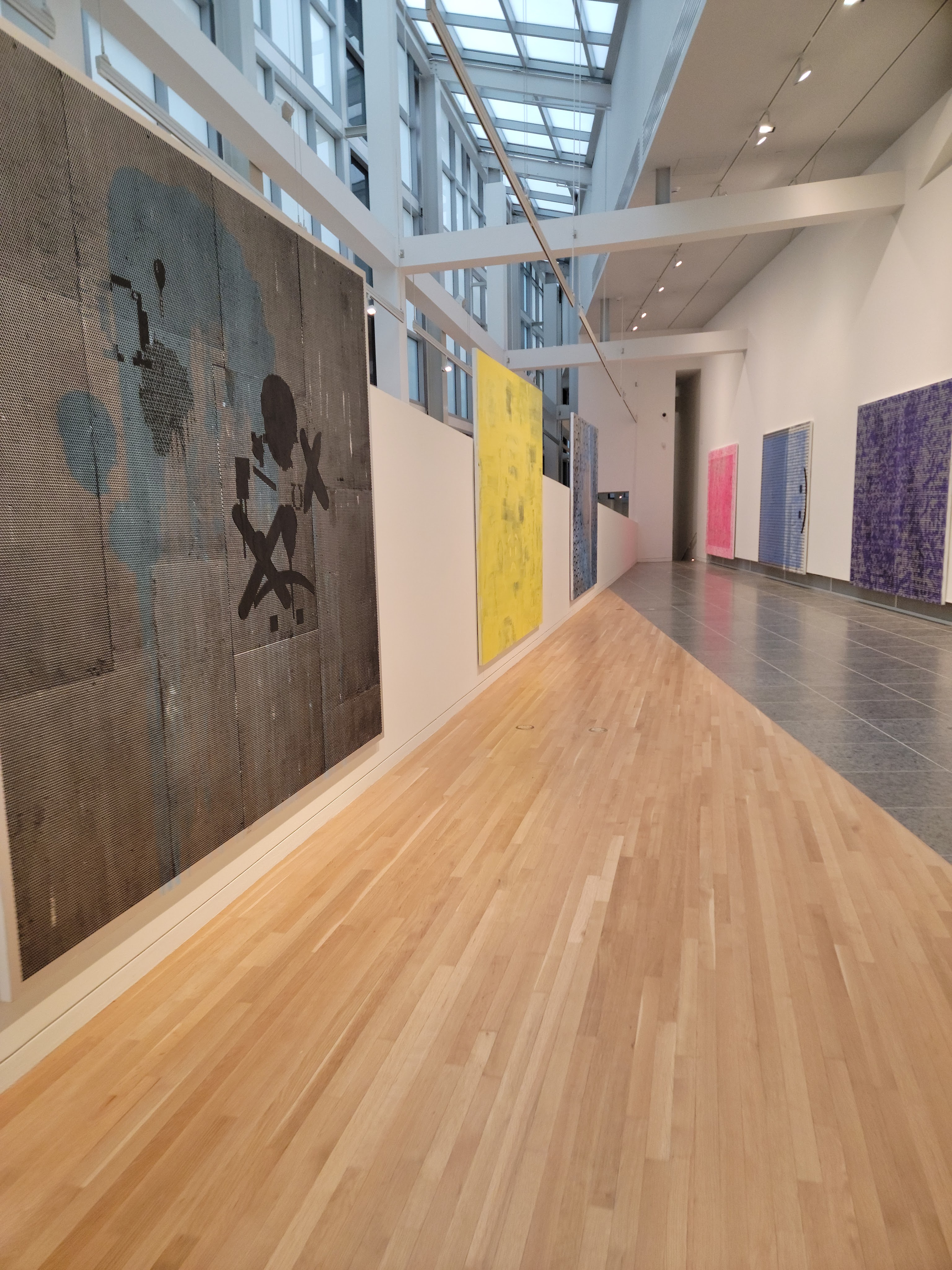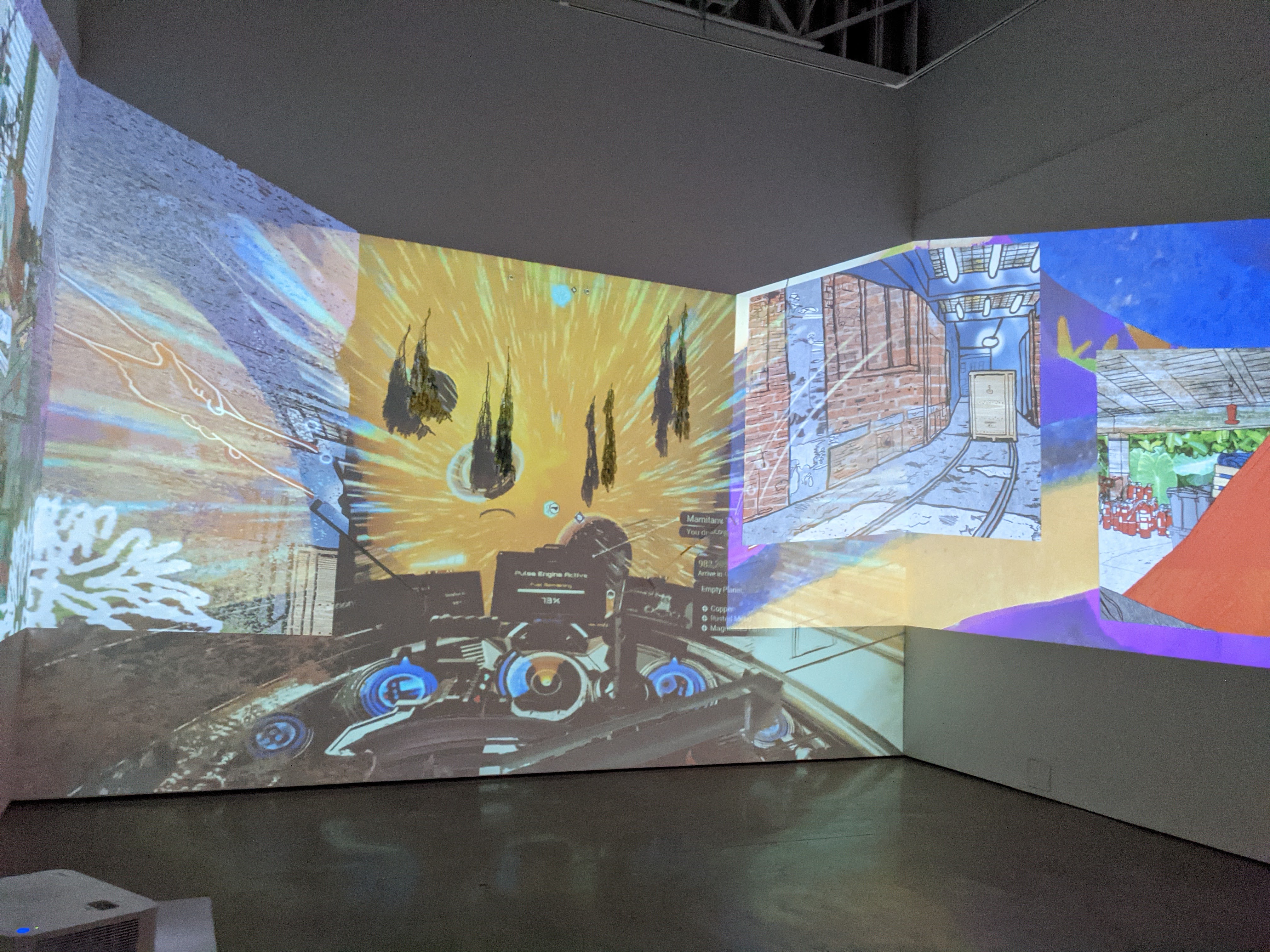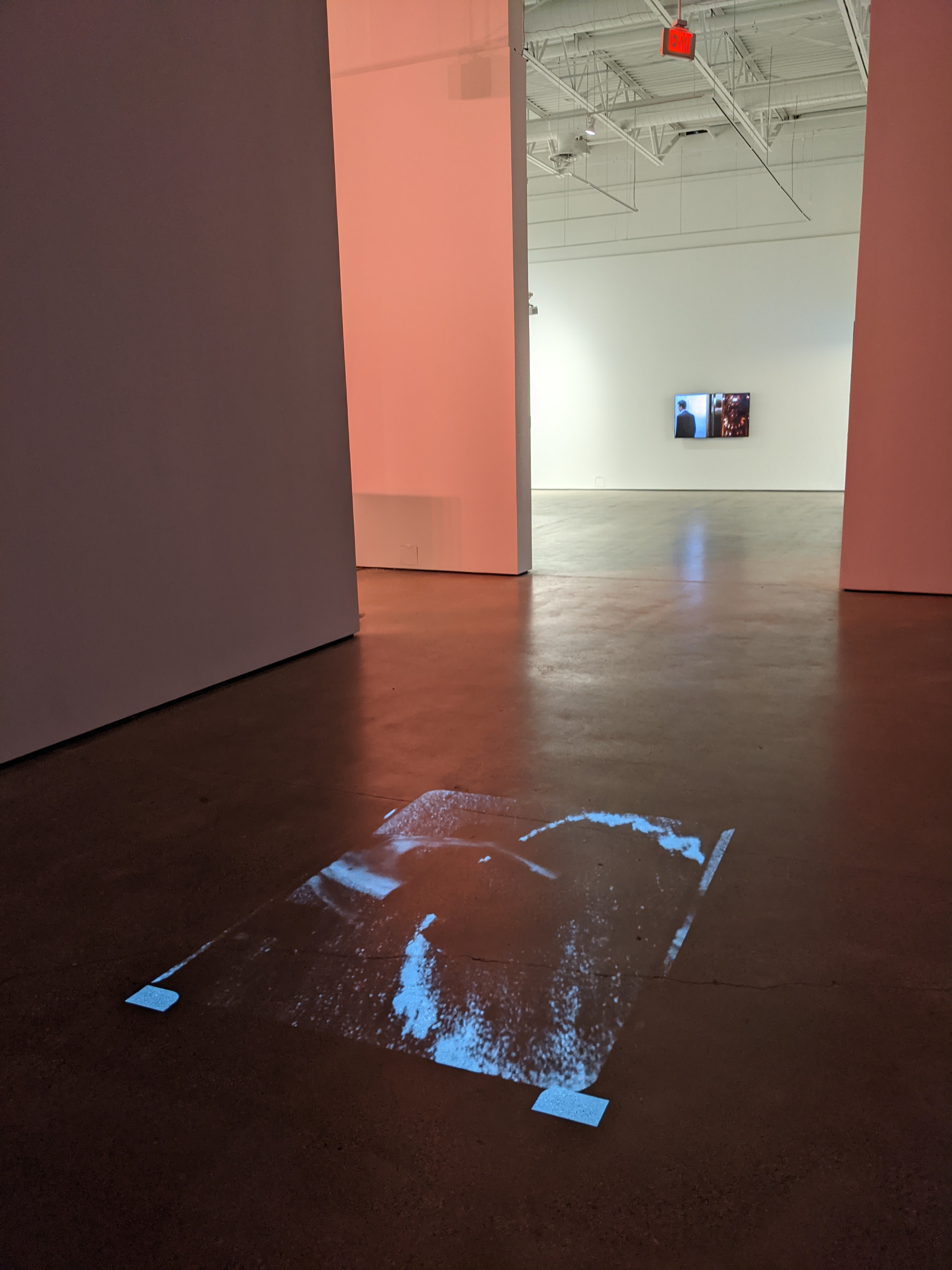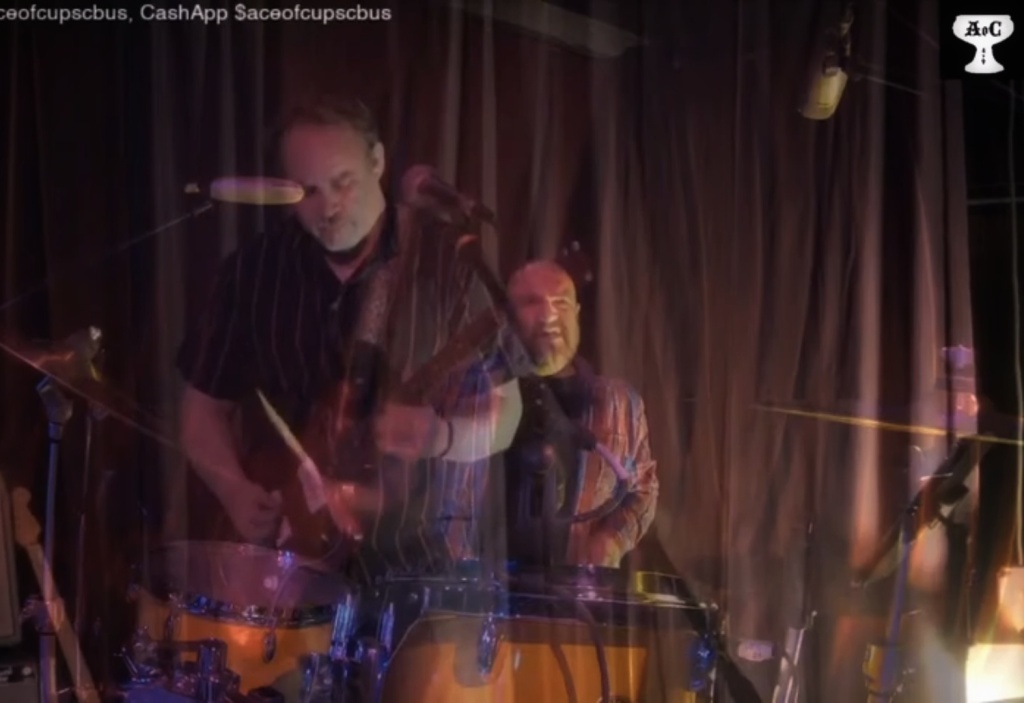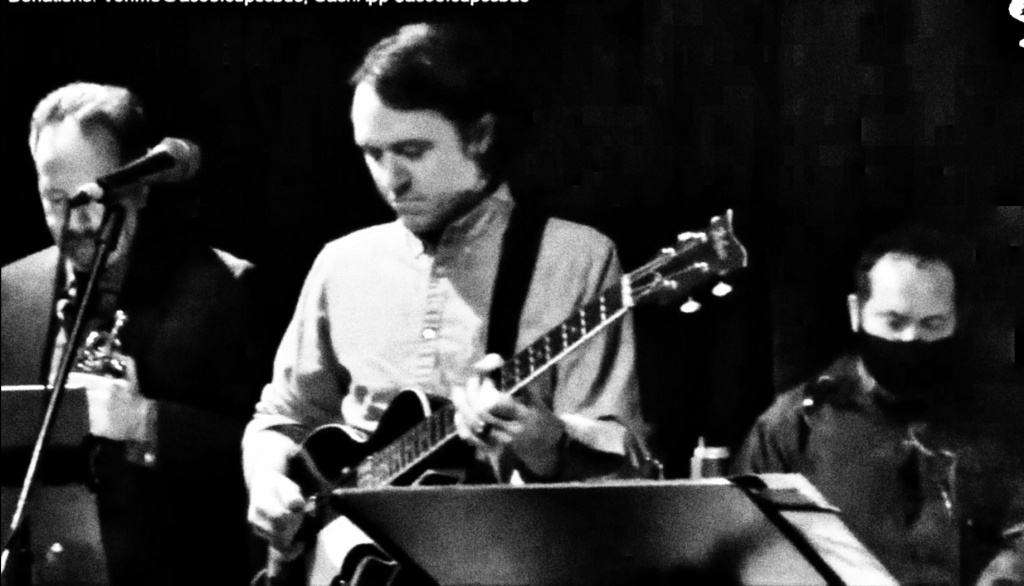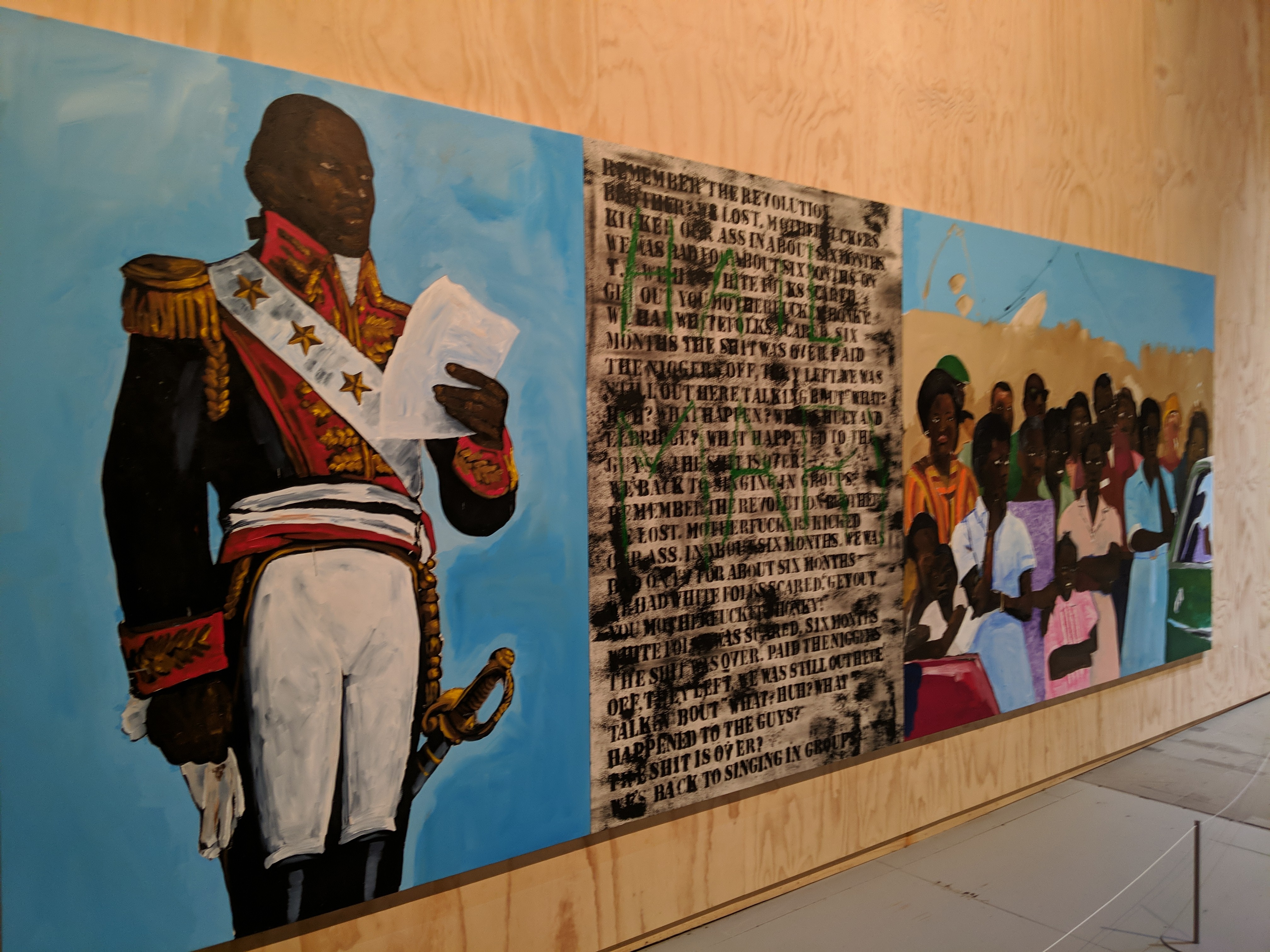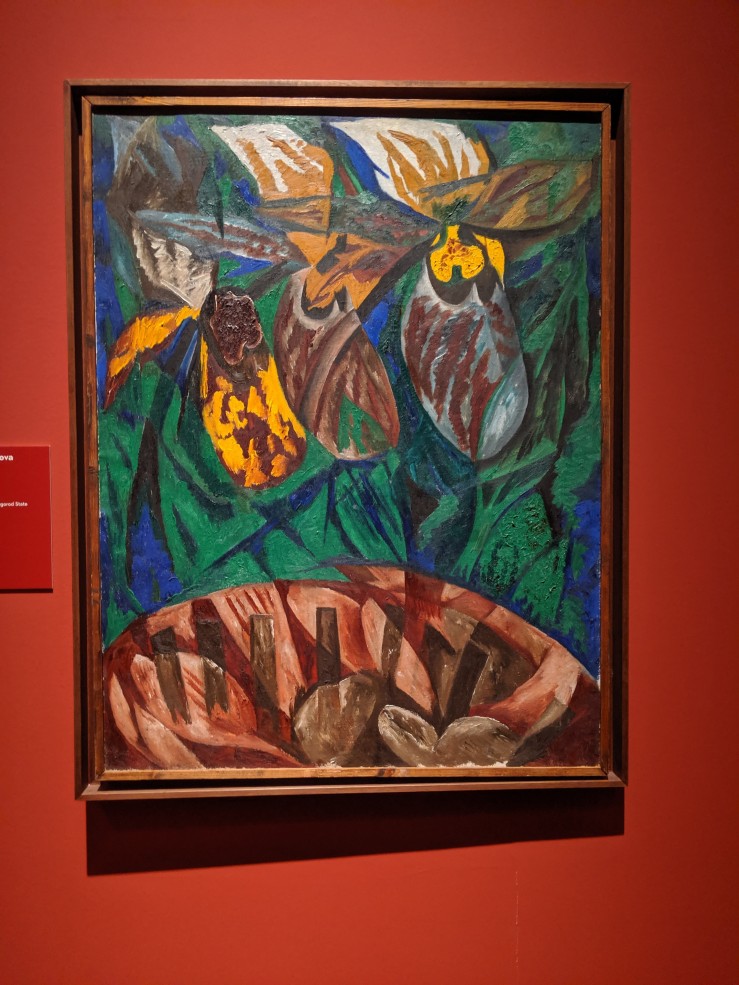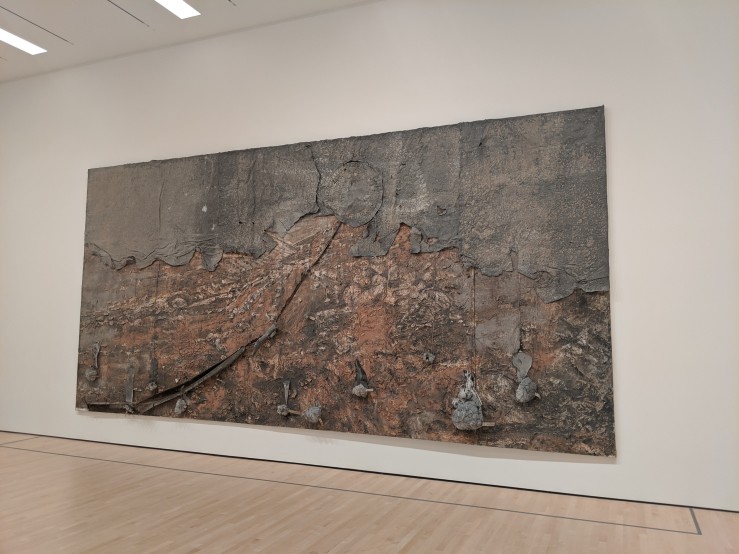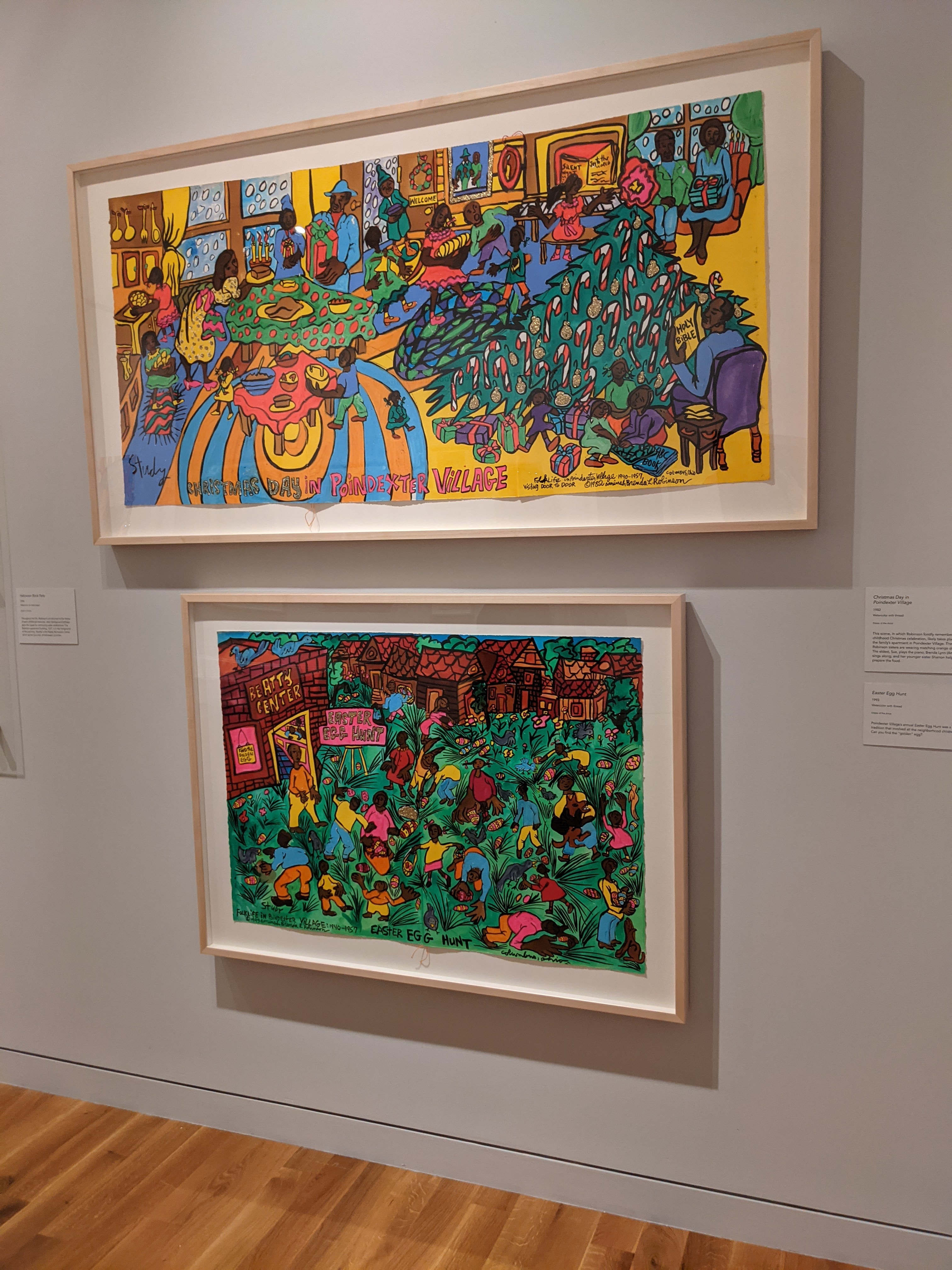
Interestingly – and don’t get me wrong, I greatly appreciate the efforts to shift to digital, distanced forms of presentation – the one medium of art I couldn’t really connect with online while we were locked down was visual art. Painting, sculpture, mixed-media all get the lion’s share of their impact on me from being in the room, breathing in the same space, seeing how much weight and density the work has, its presence.
So, the combination of not being as worried breathing in the same air as my fellow people – though I always took precautions – and the connected relief of being able to travel again, along with reconnecting with my town, meant I saw about 55 exhibits over six cities. These are the 20 that made my heart sing, my blood run cold, or both; that wouldn’t let me go. These are unranked and in chronological order.
Everything below is in Columbus and any photo is taken by me, unless otherwise noted.
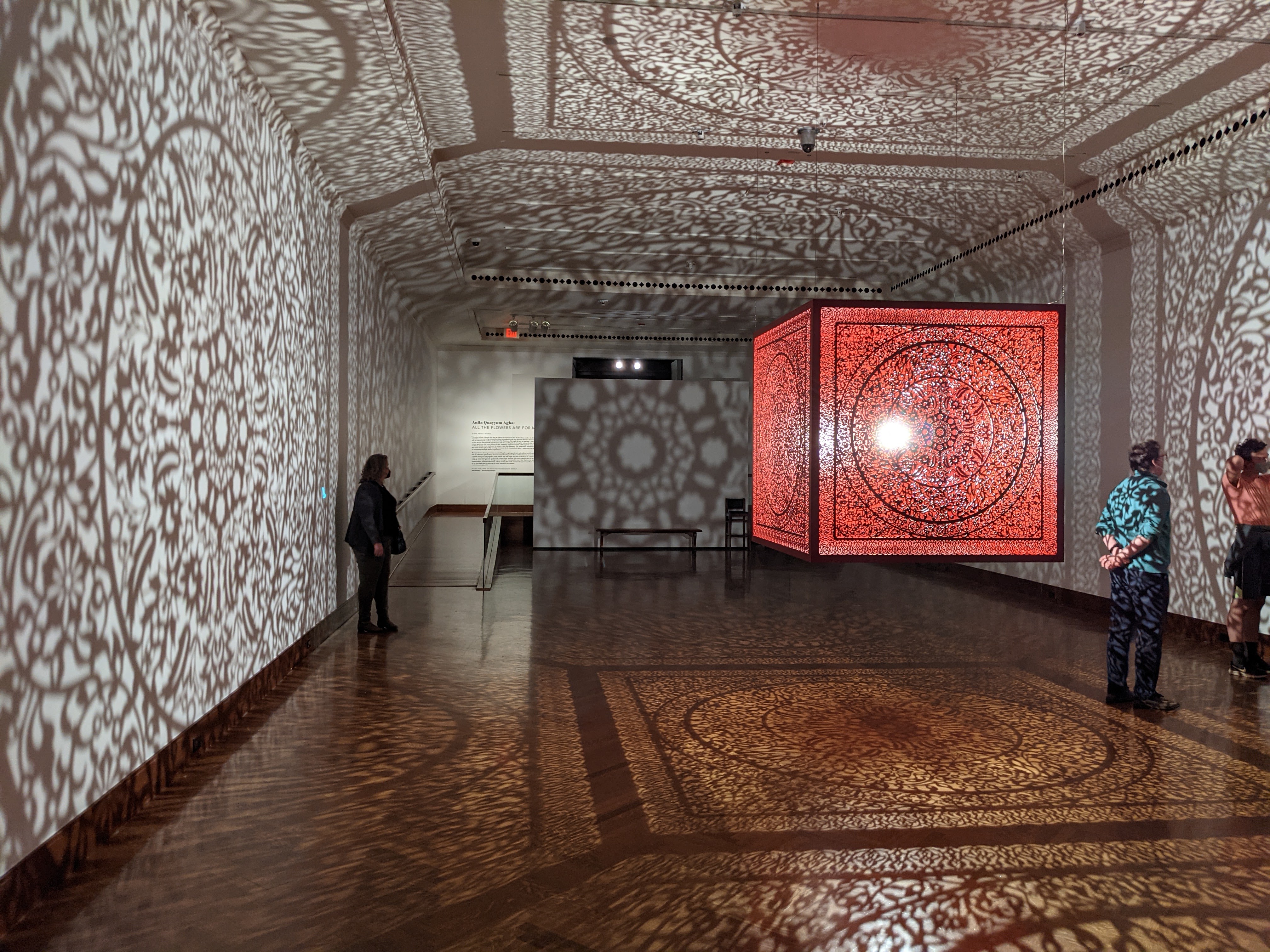
- Various Artists, November (Beeler Gallery) – The Beeler is one of my favorite spaces in Columbus and too often gets left out of the conversation, with consistently provocative commissions and group shows that benefit from the thoughtful combustion of the various works in conversation with themselves, with the CCAD Institution, with Columbus, and the world. Curator Dean Taylor exemplified all these qualities, suffused with a dread and uncertainty created for 2020 and still reverberating into February where my visit, my grappling with these deep feelings, made a sheet of ice crack inside of me.
- Anila Quayyum Agha, All The Flowers Are For Me (Cincinnati Art Museum, Cincinnati) – Stil only partially vaccinated, we went to Cincinnati for my birthday, as much outdoor and distant fun as we could muster in late March. Even under some constraints, it felt good to be out of town, dining on patios, and going to a couple of my favorite museums. Of everything Anne and I saw, I mulled over Pakistani-American artist’s meditative, expansive work, a steel-cut cube created to slice light in shadows inspired by Islamic architecture and classical art.
- Aminah Robinson, Raggin’ On (Columbus Museum of Art) – Sometimes it’s too easy to take the giants in our midst, the legends we grew up with, for granted. For too much of my youth I bristled at hearing about Aminah Robinson or James Thurber or George Bellows, though I loved their work, because I worried about how Columbus looked under a reductive lens. I’ve gotten over most of that but there are still some lingering “I know all there is to know” feelings. Within five minutes of walking into this gorgeous, immaculately curated (by Carole Genshaft and Deidre Hamlar) retrospective of one of our great artists, I was reminded I was a fucking idiot to even think that. This first retrospective since Robinson’s death hit her principal preoccupations, her recurring themes, and highlighted both the variations, the deep studies of character and place, the chimerical and literary qualities of her work, as well as the consistency of her work, in quality and thematically. I went to this three times and kicked myself for not going a dozen more. In a better world, this would have toured ten cities on three continents – as it is, it’s a stunning testament to the value of donating your estate to your local art museum.
- Various Artists, Partially Buried: Land Art in Ohio 1970-Now (Columbus Museum of Art) – Another thing I chafed at through its Ohio ubiquity as a kid? “Indian mounds.” Which I lumped land art in alongside. It took my fine arts major roommate, who idolized Andy Goldsworthy, to not only shake me out of that but show me how lucky we were to have such a tradition of it in Ohio. Anne’s enthusiasm for it later fully unlocked my appreciation, and this synthesized the tradition in a way I came back to soak in more than once. Anna Talarico’s curation drew deep lines from Robert Smithson’s seminal work that gave the exhibit its name to contemporary work like my pal Brian Harnetty’s sound piece “Forest Listening Rooms.” This was a stunning slice of history reminding us of the Faulkner line “The past is never dead, it isn’t even past.”
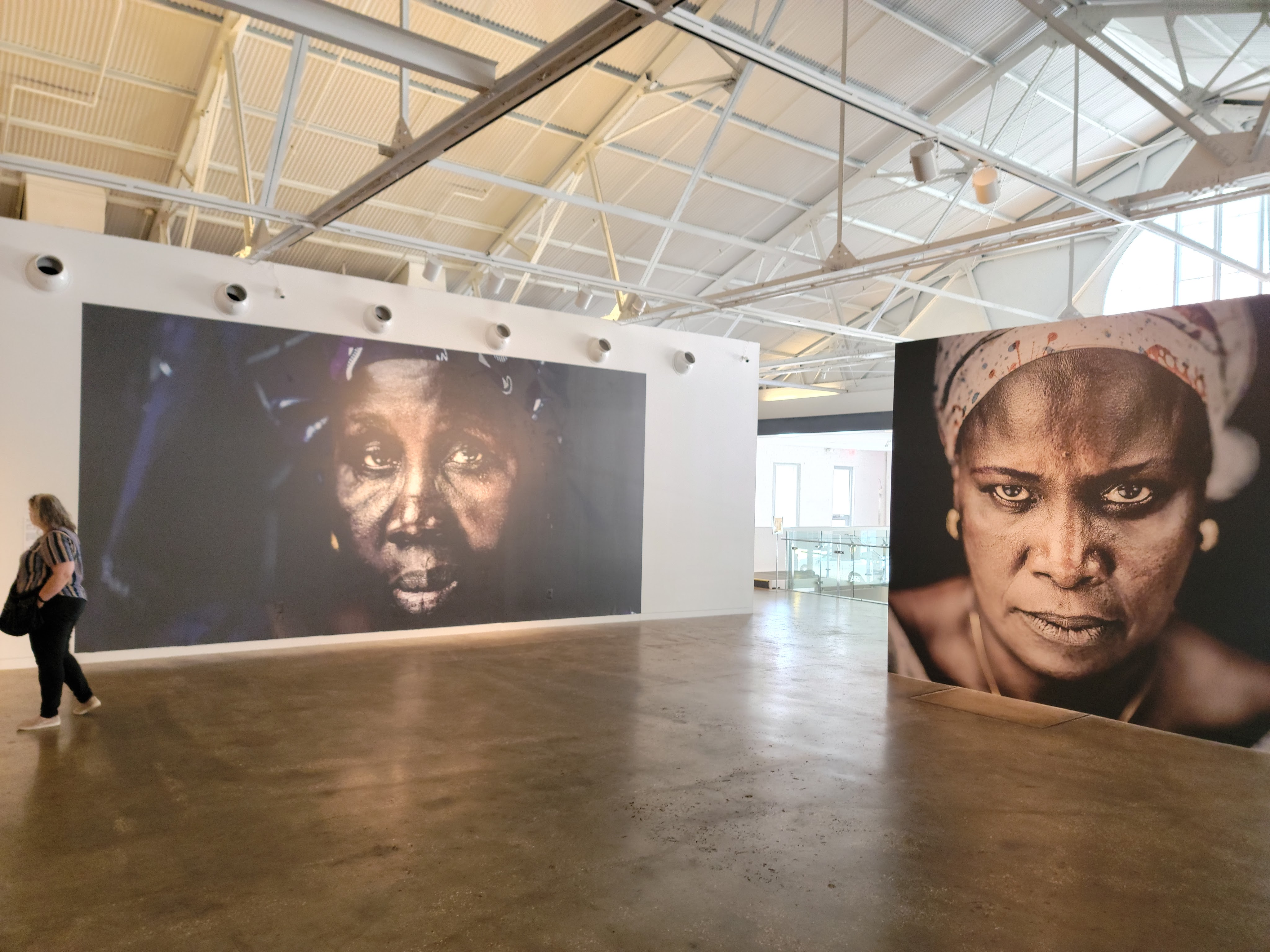
- Alun Be, Perseverance, Pride, Power (CAM, Raleigh) – These enormous photos, in close up, of women by Senegalese photographer Alun Be, knocked the wind right out of my lungs. Taking up whole walls at Raleigh’s Contemporary Art Museum, the June sun filtered by clouds through the giant windows, gave a glimpse of a whole world, whole stories these women inhabit and embody. It made the museum glow like a holy temple and a reminder of how connected we are and how important it is to hold to that connection without falling into some namby-pamby “We’re all alike” bullshit. This was a crucial reminder to respect and understand other people’s differences, their different paths, their different dreams. And a reminder to try to start with love and with a desire to understand.
- Kennedi Carter, Flexing/New Realm (CAM, Raleigh) – One of the other two exhibits at CAM, Carter’s work was new to me and hit me almost as hard. Sharing some commonalities with Kehinde Wiley’s paintings linking contemporary black culture with classical portraiture of European royalty, there’s a deeper psychological cant to her photographs I had a hard time looking away from.
- Lynn Hershman Leeson, Twisted (New Museum, NYC) – All three exhibits at the New Museum this trip made an impression on me, but Leeson’s mixed media pieces reminded me of all the promise of science fiction growing up, a truly speculative art that centers people. Enraptured by the promise of new discoveries and spectacular frontiers but with an eye toward the way the future can widen and exacerbate pain and inequality, and the entropic tendency of it to do just that if we let the same bastards hold the wheel.
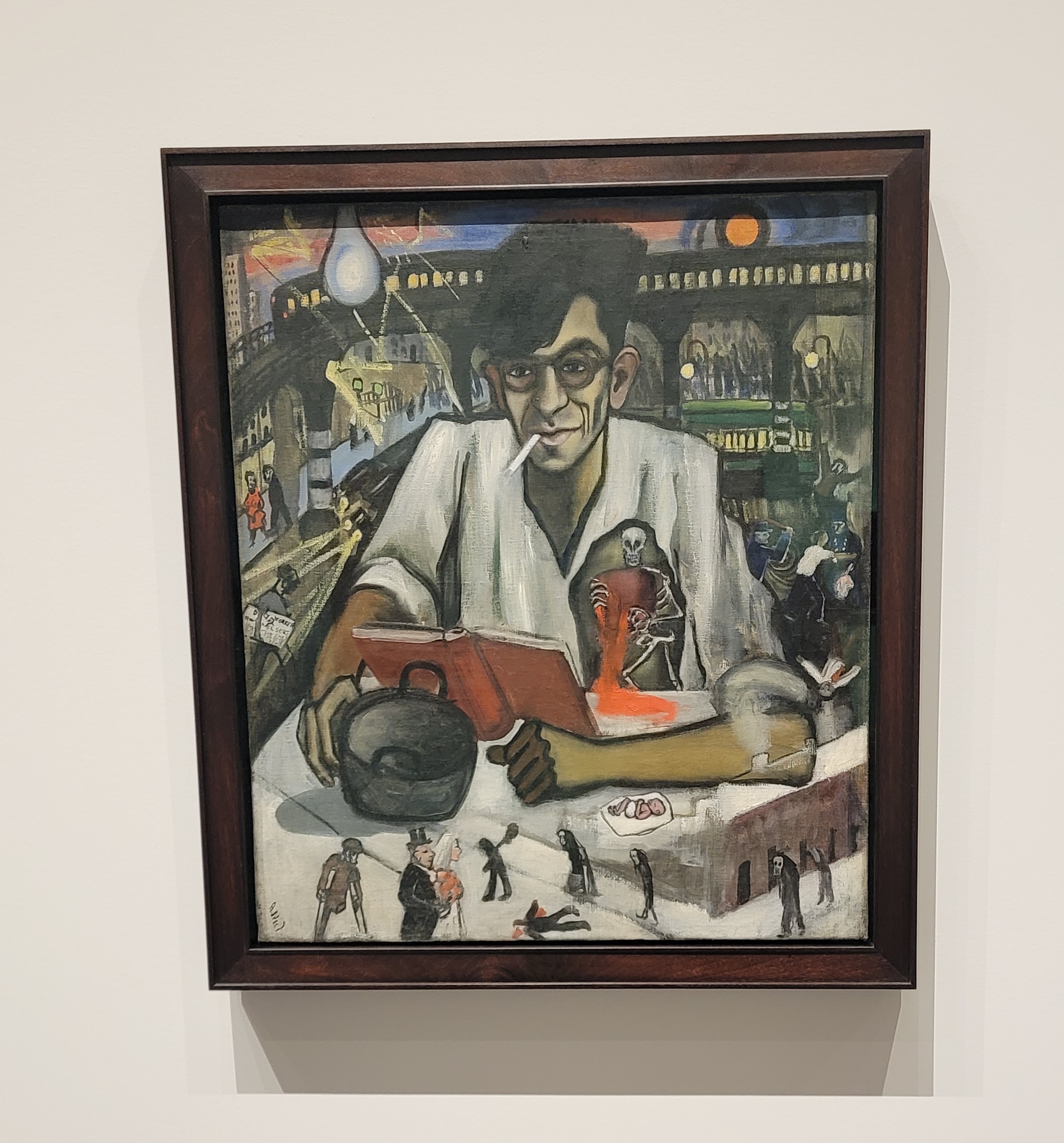
- Yayoi Kusama, Cosmic Nature (New York Botanical Garden, NYC) – I raved about Kusama a couple years ago in Cleveland, and many years back at the Whitney. She’s the kind of blockbuster, crowd-pleasing artist with so many layers and such a love of things that are messy, are complicated, that there’s always something to unpack. Pairing her work with the Bronx’s beautiful New York Botanical Garden was a perfect fit, the art and the nature vibrating together, feeding each other, giving enough surface for the selfies but enriching for the rest of us.
- Alice Neel, People Come First (Metropolitan Museum of Art, NYC) – I don’t remember the first time I saw Alice Neel’s work, but my fandom bloomed with Hilton Als’ retrospective focusing on her time in upper Manhattan at David Zwirner a few years ago and hit overdrive when I read the terrific biography by Phoebe Hoban (or did those go in the other order?). This retrospective was exactly what I go to the Met for, the kind of expansive, deep dive I’ve loved since my first trip to this temple of art to see El Greco. Neel’s ability to center people in her art and her life, to make sure her subjects are seen without judgment, is a benchmark I sometimes fuck up but always try to shoot for. And the work is gorgeous beyond reckoning.
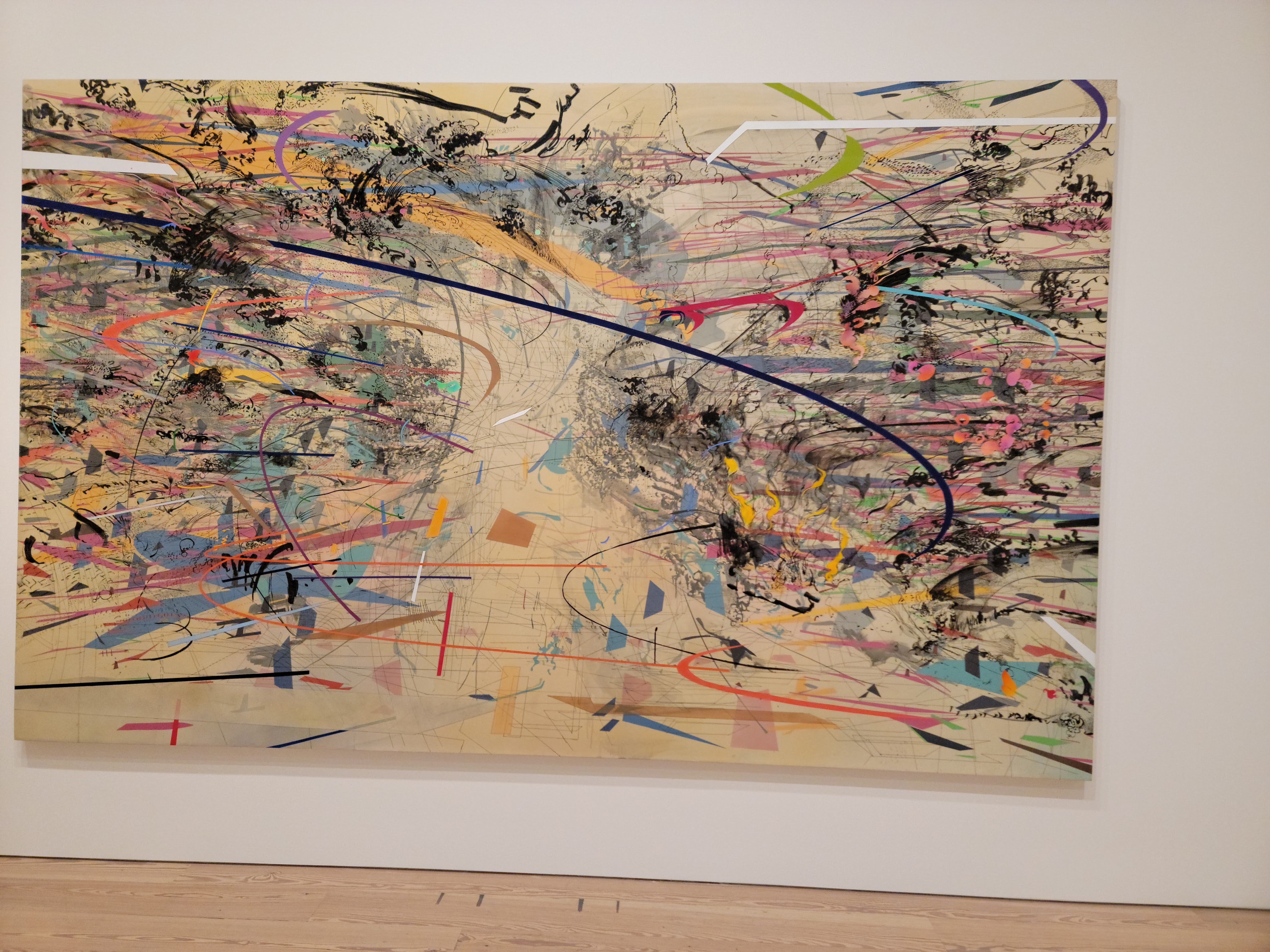
- Julie Mehretu, Julie Mehretu (Whitney Museum, NYC) – I’d seen a couple pieces by Ethiopian artist Julie Mehretu before, but this dazzling retrospective shone light on her unique style of abstraction and her way of viewing the world as a collection, a melange, maps that feel right but don’t draw a linear story. One of the most vital, vibrant abstract painters I’ve been turned onto in many years.
- Dawoud Bey, An American Project (Whitney Museum. NYC) – Another vital eye on the current moment, Dawoud Bey’s work struck me as soon as I saw it. This retrospective showed his incisive, open-hearted approach from his ‘70s portraits in Harlem to the mysterious, speculative landscapes evoking underground railroad passages from 2018. Seeing this the day after Alice Neel and these artists decades apart, though they overlapped, finding ways to center humanity in their art, was awe-inspiring. Anne and I posted up at Radio Bar and talked about this for an hour after.
- Various Artists, Ashcan School Prints and the American City: 1900-1994 (Cleveland Museum of Art, Cleveland) – I overloaded on the Ashcan school as a kid, partly because of Columbus native George Bellows’ prominence in it and partly because I was drawn to a level of social realism. Some time away from that let me see this terrific retrospective at the Cleveland Museum with fresh eyes and I was stunned by the breadth and intensity of that work and its uniquely American patina.
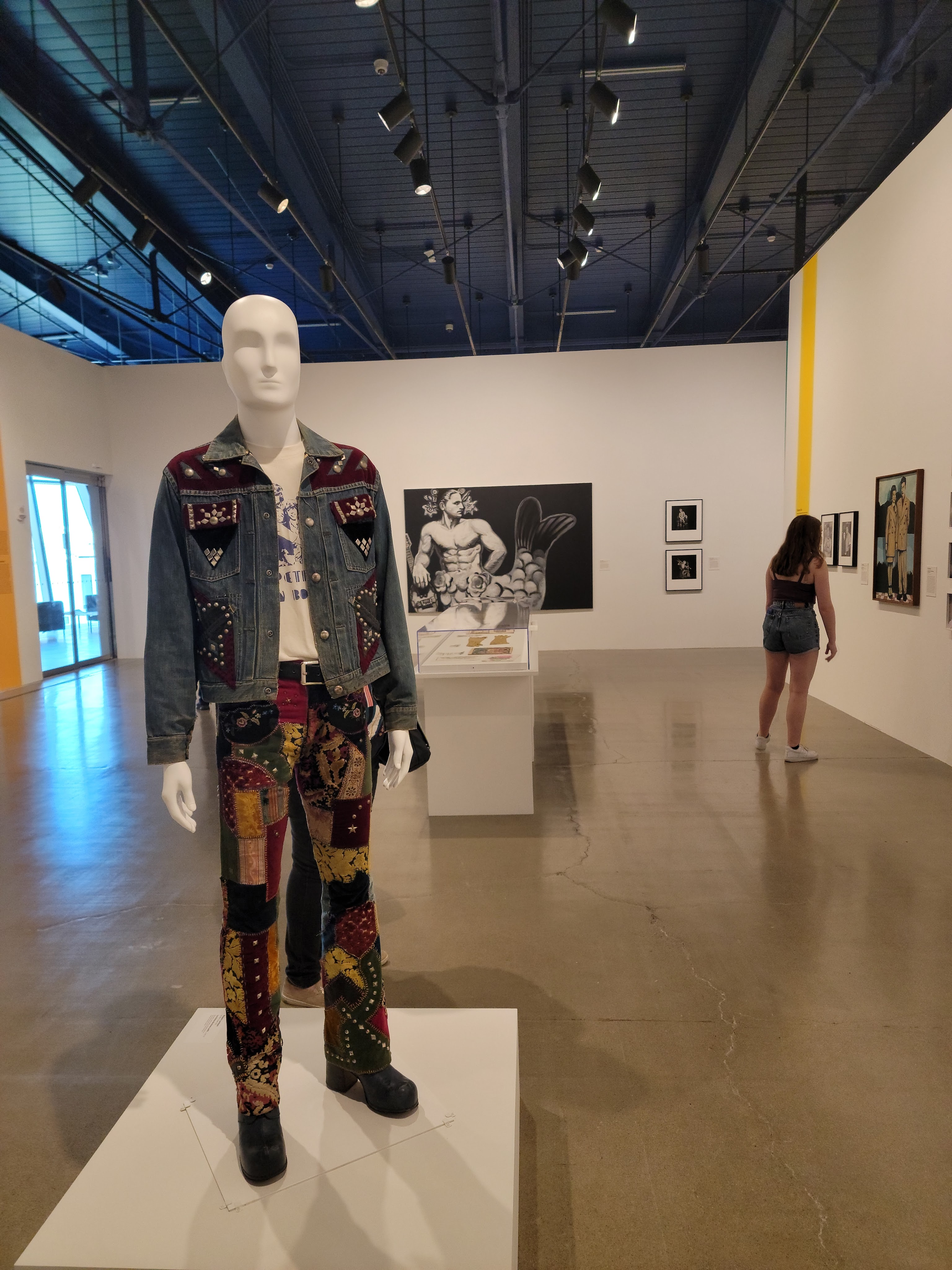
- Various Artists, Axis Mundo: Queer Networks in Chicano LA (MOCA, Cleveland) – This MOCA exhibit made a series of puzzle pieces fall into place in my head. I knew how impactful the Latinx communities were on Los Angeles history and especially that punk scene I grew up idolizing. Until this, I hadn’t seen something that tied the various LA art scenes together so sharply (in the way I’ve seen a million books/exhibits/articles do for New York of the same time period) and emphasizing seeing these scenes through a Chicano lens, immaculately curated by C. Ondine Chavoya and David Evans Frantz. This set my hair on fire.
- Danielle Deley and Allison Baker, Home (934 Gallery) – 934 Gallery is one of the Columbus gems and when I stopped at their 934 Fest I had the chance to check out a fantastic exhibit – Home – that placed Danielle Deley’s huge-canvas explorations of her Catholic background in dialogue with Allison Baker’s razor-edged investigations of what we think of as domesticity and women’s work in dialogue with each other and the space.
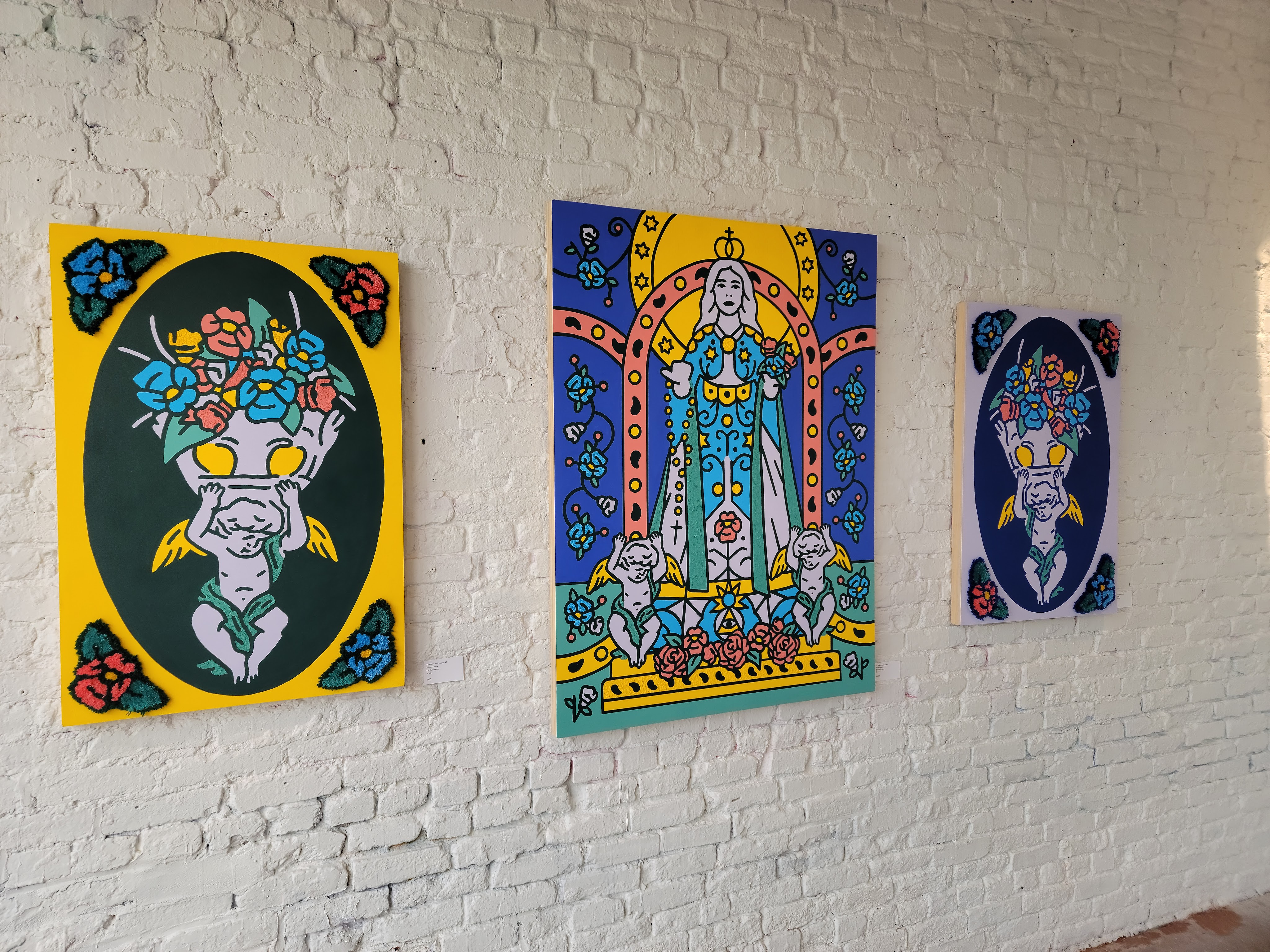
- Wayne Thiebaud, Wayne Thiebaud at 100: Paintings, Prints, and Drawings (Dixon Gardens and Gallery, Memphis) – In all my trips to Memphis, including repeated visits to the botanical garden, Anne and I hadn’t yet made it to Dixon Gardens and Gallery. We corrected that this trip – it reminded me of a Southern Frick – with a stunning retrospective of Wayne Thiebaud. His looks at urban landscapes, the sensual pleasures of food, and the rapidly changing 20th century struck a particular pleasure center for me I’m not sure any other art did this year.
- Mark Selinger, On Christopher Street: Transgender Portraits (Brooks Museum, Memphis) – The Brooks has become one of my favorite museums over repeated treks to Memphis and they’ve got a particularly good eye for photography exhibitions. This year, Selinger’s (whose work I knew from GQ) contemporary look at the storied cobblestones of Christopher Street and its transgender residents and visitors blew me away. A moving look at connection without trying to underplay their differences, another reminder at the powerful capacity for empathy visual art possesses.
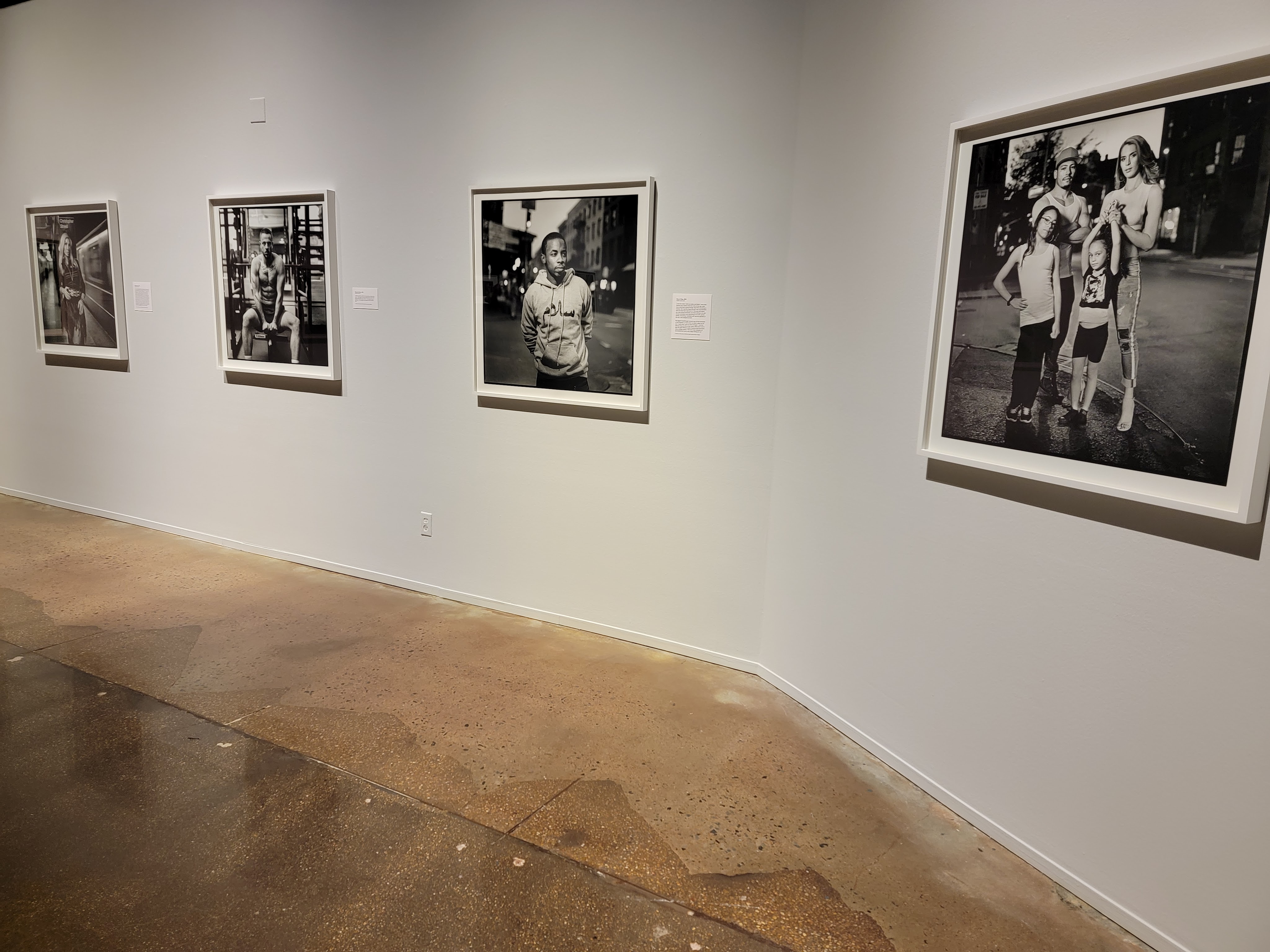
- Nina Katchadourian, To Feel Something That Was Not Of Our World (Pizzuti Collection of the Columbus Museum of Art) – This fascinating exhibit delved into the survival memoir Survive the Savage Sea, with translations of the book, excerpts, life-size drawings of tortoises and whales, audio recordings, and printed messages exchanged between the artist and the family. It’s a beguiling look at what makes us survive, what keeps people from giving up, and family in the best sense, atomized and displayed in ways I didn’t expect.
- Bruce Robinson, Flutterby (Pizzuti Collection of the Columbus Museum Art) – The other exhibit in the Pizzuti Collection was longstanding CCAD professor Bruce Robinson’s work. Motion is at the center of all these pieces, some abstract, and this had an interesting resonance for me with the other people-centered exhibits I saw this year. There’s a special bravery and a special open-heartedness in including your friends, your community, in your work that has to encompass your feelings for them but also stand outside of your specific experience. This helped reinforce all the feelings I grasped for all year.

- Carol Stewart and Janice Lessman-Moss, Still Is Still Moving (Hammond Harkins Gallery) – I don’t stop at Hammond Harkins that often but the sunny Saturday afternoon I popped in wowed me. These two carefully chosen artists, both of whom have histories with the gallery and with Columbus, sparked against each other, leading me on a long, fascinating conversation with the gallery employee/attendant/manager who was there at the time. Lessman-Moss’s textile pieces used metallic thread for contrast in stunning geometric patterns. Stewart’s still lifes actually made the artifice in any still life concrete for me in a way I’m not sure I’ve ever seen – the deliberate placement of everything in the picture frame was done with intention and deliberation but – like Jeff Wall’s photographs – that artifice makes them more intriguing and more full of life, not stiffer. These two approaches, talking to each other across the room, under the banner of the Willie Nelson lyric the show is named for, left me chewing on them for weeks.
- Jacqueline Humphries, jHΩ1: ) (Wexner Center) – I went to see this stunning Humphries retrospective four times and I’m still not sure I got it but I loved it. I said to a friend who saw it a different time, “I felt like I was drowning but not in an unpleasant way.” These expansive abstractions of the data and metaphor we’re all swimming in are as messy and as orderly, as intense, as my first impressions of Kusama or Rothko or Agnes Martin. It’s a knockout blow to end the year on.
